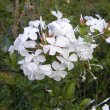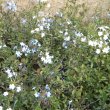| Botanical Name |
Plumbago auriculata - white |
| Family |
Plumbaginaceae - The leadwort or plumbago family. |
| Pronunciation |
plum-BAY-go aw-rik-yoo-LAY-tuh |
| Common Name(s) |
IsiZulu: Utshilitshili; umabophe
|
| Plant Group |
- Shrub A woody plant of relatively low height, having several stems arising from the base and lacking a single trunk; a bush.
|
| Plant Size |
- Medium
| Tree | 10m to 16m |
| Shrub | 1m to 2m |
| Perennial/ground cover | 40cm to 60cm |
| Bulb | 40cm to 60cm |
| Succulent | 40cm to 60cm |
|
| Position |
- Canopy Shade Canopy shade is found below closely grown trees where some light filters through. Ideal for the protection of herbaceous plants.
- Light or Dappled Shade Found below trees with sparse, open foliage. Ideal for the protection of herbaceous plants.
- Partial Shade The area is in shade for part of the day and in full sun for part of the day.
- Sun The area is in full sun for all or most of the day, all year round.
|
| General Information |
- Drought Tolerance: High The plant is well adapted to arid conditions; it can survive long periods of drought and high temperatures without extra water.
- Evergreen Plants that have leaves all year round.
- Frost: Half-hardy The plant is able to survive low temperatures and some frost but requires protection against severe frost.
- Prune hard after flowering Fast growing shrubs that grow lanky within a season. Cut off branches and stems of these plants to a third of their original length. This will increase the yield of flowers, improve the plants shape and enhance the structural strength of main branches.
- Water Wise Plant species originating from low rainfall regions that require less water to survive and thrive than other plant species.
|
| Specific Information |
The white version of Plumbago auriculata seems less vigorous than the blue, the specimens in the bush being small and seldom seen. A useful plant to train as a shrub in a smaller garden or in a container, as it responds well to pruning and shaping.
|
| Ad Break |
|
| Flowers |
| Description |
almost flat with 5 rounded petals
|
| Season |
- Summer to Autumn Plants will seldom bloom for the entire season as given in the list, but should flower during a period within these parameters.
|
| Colour |
|
| Growth Rate |
- Moderate Specifying growth rate can be very misleading as there is considerable variation of growth rate depending on type and species of plant, available water, supplementary feeding, mulching and general care, as well as the plants suitability and adaptability to the garden environment.
|
| Plant Uses |
- Attracts bees, butterflies or other insects This plant attracts insects which can be food for birds or other creatures in your garden.
- Border A strip of ground, at the edge of a driveway or path in which ornamental plants or shrubs are planted.
- Boundary A plant useful for planting around the edges of the property to form a green or colourful backdrop, an impenetrable hedge, to hide walls or create privacy.
- Container Trees, shrubs and ornamental species that can adapt to growing in a restricted environment.
- Hedge Suitable trees or shrubs planted relatively close together so that the branches intertwine to create a barrier. This can be formal – the plants are regularly trimmed to produce a neat shape, or informal – the plants are left to themselves to create a natural hedgerow.
- Suitable for coastal gardens Plants adapted to dry, sandy soil, forceful wind, limited rainfall and intense sunlight.
- Suitable for smaller gardens Such plants do not have invasive root systems, remain small or controllable and can often be grown in containers.
|
| Distribution and Habitat |
from the eastern part of the Western Cape to the Eastern Cape and into KwaZulu-Natal. There are also distributions in Gauteng, the Free State, North West Province and Mpumalanga.
|
| Planting Suggestions |
Plumbago will grow in any soil but will perform best if planted with plenty of compost and a thick layer of mulch. Water regularly until established, then taper off if water is scarce.
|
| Medicinal Uses |
Traditionally Plumbago is used for the treatment of warts, broken bones and wounds, and as a snuff to treat headaches and to dispel bad dreams. A stick of the plant is tucked into the thatch roof of huts to discourage lightning.
|
| Ad Break |
|






Comments
medicinal uses
what are the medicinal uses of the plumbago auriculata?
Medicinal uses
Hi Sihle
Thanks for your query. I have updated the medicinal uses above.
Kind regards
Lorraine
Discuss this plant
Share knowledge, ask a question or give an experience.